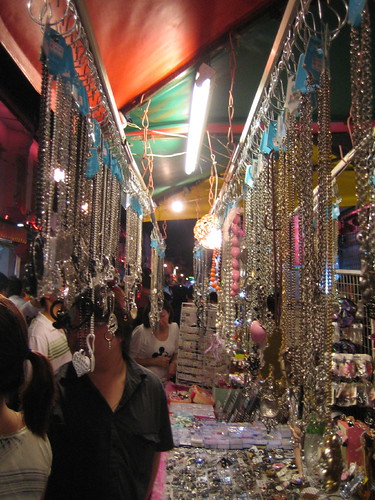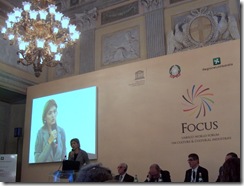Unexpected Pleasures is an extraordinary achievement. Curator Susan Cohn has gathered together more than 200 key works reflecting the international scene of contemporary jewellery. This mass of work is surprisingly digestible. Rather than arrange them by country or historical movement, she has offered a taxonomic system that maps the creative energies at play in individual pieces.
These ‘idea clusters’ are quite different to the more reductive classifications that might otherwise be found in museums, based on materials or techniques. For instance, ‘Logical solutions’ attends to the creative dimension of componentry in jewellery works. The propositional nature of such groupings engages the visitor more actively than those based on academic criteria.
There’s much more that can be said about the exhibition as a whole, but I would like to respond to one of the specific challenges laid in the section titled A Fine Line. This closed installation at the centre of the gallery functions as the ‘navel’ of the exhibition, identifying the ‘origins of contemporary jewellery today’ in Art, Design, Fashion and Craft.
Practically, this is an opportunity to feature iconic works, such as Annie Alberts’ ‘Necklace’ made from paper clips that prefigures more experimental work to come. More generally, this contextualisation locates contemporary jewellery in a broader kinship system of creative arts.
This is by no means a neutral context. There is a clear value system at work in the way these origins are presented. While works by artists such as Alexander Calder are celebrated, Art as a framework for jewellery creates a remove between the artist and the work. Artists are seen to create jewellery as mostly a secondary concern, akin to merchandising. This distance from making applies to Design as well, though the designer is more comfortable the process of production:
A designer with the ability to create effective jewellery has the sensibility to understand industrial objects with a certain sophistication.
Fashion includes elements of art, design and craft, but it has the additional capacity to engage with sub-cultures in which individuals adapt clothing to create their own identities.
The final origin, Craft, is presented as ‘problematic’. The text argues that it is better to avoid the word in order to overcome ‘ultimately futile questions about the allegedly nostalgic connotations of craft.’ Parallel to fashion, this origin is presented as ‘vernacular self-expression in the anthropological sense.’ There’s a certain unresolved tension here between making and empowerment that prompts further consideration.
In the book accompanying the exhibition, craft is illustrated with a Bella Herdsman’s pendant from Birkina Faso (1976) and a photo of an ash-covered Dinka elder (1976) wearing a necklace of Dutch beads and smoking an elaborate silver pipe. In the exhibition itself, craft is represented by an armband from Arnhem Land (1993). We see craft through these works as something distant from Western culture.While the craft section does state that making is relevant to contemporary jewellery, it is positioned in the exhibition as something performed by those ‘other’ to our culture. There are precedents for this. Primitivism has been a key influence in contemporary jewellery, particularly in our corner of the world with Peter Tully and Warwick Freeman. But this primitivism has been mediated by the artists themselves, rather presented as museum pieces.
So what’s happening in this return to ethnography in contemporary jewellery? Maybe it’s progressive. This return could be seen as part of a wider concern to give indigenous arts themselves a platform. Rather than have white artists represent non-Western cultures, it is better to give a voice to those who belong to those same cultures, as in the emergence of a new generation of Aboriginal and Maori jewellers. However, the works identified as ‘craft’ in Unexpected Pleasures are anonymous, so there is little opportunity to enfranchise non-Western artists.
The other side of this is the implied detachment of contemporary jewellery from craft. I think there are two currents at play here. The first is the exhibition’s resolutely cosmopolitan approach. While there are some references to place, such as the Dutch collar of Paul Derrez, contemporary jewellery is represented here as a relatively placeless activity. It is perhaps a sign of maturity that it, like other disciplines such as science or architecture, is presented as an autonomous profession which prizes originality above political correctness. The framework of Craft is at odds with this specialisation. It tends to be more location specific, reflecting traditional skills and local materials. Craft’s implied responsibility to place has potential to compromise creative freedom.
This is a different case for Craft than the one which Robert Baines would make in criticism of the exhibition. Baines champions the discipline of skill and tradition in contemporary jewellery. I would argue that skill does have a link to place. The logic of outsourcing in late capitalism has helped us overlook this.
The second current is the exhibition’s attempt to celebrate the wearer. This is critical to an exhibition which has the capacity, in an unparalleled way, to open up the closed circle of contemporary jewellery to the broader public. Unexpected Pleasures is cast initially to fit the National Gallery of Victoria, which has never before offered a survey exhibition of contemporary jewellery. Craft in this context provides a more internal framework of skill and mastery best understood by the makers themselves. It thus has potential to alienate the broader public.
At the other pole, the exhibition must satisfy the interests of the London Design Museum. A natural framework for Design is to consider contemporary jewellery in terms of its role in everyday life. How does jewellery affect the way people behave in the street? Certainly, the works in Unexpected Pleasures can be read in terms of user experience, such as the framing neckpieces of Gijs Bekker and Otto Künzli. But could this go further? The majority of works are still made primarily for exhibit rather than use. We don’t see work than has been subject to the additional discipline (or compromise) of the market.
Ironically, the one contemporary jeweller who seems to embrace this element of design most fully is Susan Cohn herself. The necessary absence of her work in Unexpected Pleasures is one of the few weak points.
Unexpected Pleasures is likely to prove a seminal moment in contemporary jewellery. It shifts the focus away from the subjective experience of the maker to the desires of the wearer. While this seems a necessary move, it leaves making itself in an uncertain place. Its association with indigenous culture is perhaps a holding position, acknowledging the presence of Craft while separating it from mainstream practice.
This lack of resolution opens the potential for a counter move. The alternative is more about treasures than pleasures—jewellery as a means to forge new and recovered collectivities.












